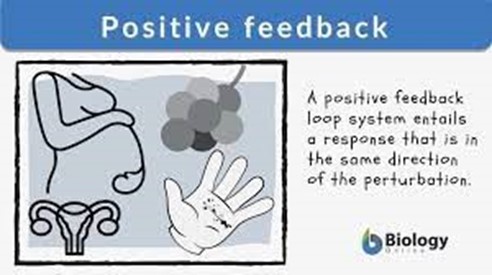Positive feedback mechanisms:
Usually produce stable conditions.
Cause long-term changes.
Move conditions away from the normal state.
Bring conditions back to the normal state.
The Correct Answer is C
Positive feedback mechanisms move conditions away from the normal state.

They amplify the original action and produce more of the same effect.
For example, blood clotting and childbirth are positive feedback mechanisms.
Choice A is wrong because positive feedback mechanisms usually produce unstable conditions.
They do not resist change but rather enhance it.
Choice B is wrong because positive feedback mechanisms do not cause long-term changes.
They are ultimately stopped by negative feedback loops once the process they were used for is complete.
Choice D is wrong because positive feedback mechanisms do not bring conditions back to the normal state.
That is the role of negative feedback mechanisms, which oppose the stimulus and restore homeostasis.
Nursing Test Bank
Naxlex Comprehensive Predictor Exams
Related Questions
Correct Answer is A
Explanation
The mitral valve lies between the left atrium and left ventricle and prevents the regurgitation of blood from the ventricle back into the atrium.

It has two leaflets that open and close to allow blood to flow from the lungs into the left atrium and then to the left ventricle.
Choice B is wrong because the tricuspid valve lies between the right atrium and right ventricle and prevents the regurgitation of blood from the ventricle back into the atrium.
It has three leaflets that open and close to allow blood to flow from the body into the right atrium and then to the right ventricle.
Choice C is wrong because the pulmonary valve lies between the right ventricle and the pulmonary artery and prevents the regurgitation of blood from the artery back into the ventricle.
It has three leaflets that open and close to allow blood to flow from the right ventricle to the lungs, where it picks up oxygen.
Choice D is wrong because the aortic valve lies between the left ventricle and the aorta and prevents the regurgitation of blood from the aorta back into the ventricle.
It has three leaflets that open and close to allow blood to flow from the left ventricle to the rest of the body.
Correct Answer is A
Explanation
The right atrium receives blood directly from the superior vena cava, inferior vena cava, and coronary sinus.

The superior vena cava and inferior vena cava bring deoxygenated blood from the upper and lower body, respectively.
The coronary sinus brings blood from the heart muscle.
Choice B is wrong because it excludes the coronary sinus, which also empties into the right atrium.
Choice C is wrong because it includes the pulmonary veins, which carry oxygenated blood from the lungs to the left atrium, not the right atrium.
Choice D is wrong because it only includes the pulmonary veins, which are not connected to the right atrium at all.
Whether you are a student looking to ace your exams or a practicing nurse seeking to enhance your expertise , our nursing education contents will empower you with the confidence and competence to make a difference in the lives of patients and become a respected leader in the healthcare field.
Visit Naxlex, invest in your future and unlock endless possibilities with our unparalleled nursing education contents today
Report Wrong Answer on the Current Question
Do you disagree with the answer? If yes, what is your expected answer? Explain.
Kindly be descriptive with the issue you are facing.
